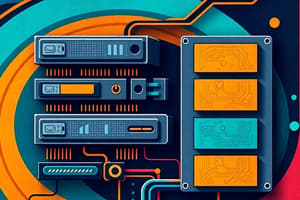Podcast
Questions and Answers
Redundancy ensures that data is always accessible when needed.
Redundancy ensures that data is always accessible when needed.
True (A)
The kernel of an operating system is responsible for user interface design.
The kernel of an operating system is responsible for user interface design.
False (B)
Harvard architecture allows simultaneous access to data and instructions.
Harvard architecture allows simultaneous access to data and instructions.
True (A)
RISC systems typically use a larger set of instructions compared to CISC systems.
RISC systems typically use a larger set of instructions compared to CISC systems.
The transport layer is responsible for moving packets from the source to the destination.
The transport layer is responsible for moving packets from the source to the destination.
Utility software is primarily used for data transmission across networks.
Utility software is primarily used for data transmission across networks.
Emulation refers to the process of replicating another computer system on a different device.
Emulation refers to the process of replicating another computer system on a different device.
Ethernet connections facilitate high mobility for networked devices because they do not require physical connections.
Ethernet connections facilitate high mobility for networked devices because they do not require physical connections.
Checksum algorithms help to detect errors by comparing values calculated before and after data transmission.
Checksum algorithms help to detect errors by comparing values calculated before and after data transmission.
TCP prioritizes speed over reliability when sending data across networks.
TCP prioritizes speed over reliability when sending data across networks.
Vector graphics are not composed of pixels and can be resized without losing quality.
Vector graphics are not composed of pixels and can be resized without losing quality.
Full duplex communication allows devices to send and receive data simultaneously.
Full duplex communication allows devices to send and receive data simultaneously.
A character data type can only store whole numbers.
A character data type can only store whole numbers.
The Memory Address Register (MAR) holds the actual data fetched from memory.
The Memory Address Register (MAR) holds the actual data fetched from memory.
Asynchronous data transmission does not require synchronization between devices.
Asynchronous data transmission does not require synchronization between devices.
Parity checking can only determine if a binary set has an even number of ones.
Parity checking can only determine if a binary set has an even number of ones.
Cyclic Redundancy Check (CRC) is less effective at catching errors than a simple checksum.
Cyclic Redundancy Check (CRC) is less effective at catching errors than a simple checksum.
In parallel transmission, multiple bits are sent simultaneously which can lead to more synchronization issues over long distances.
In parallel transmission, multiple bits are sent simultaneously which can lead to more synchronization issues over long distances.
Flashcards
Redundancy
Redundancy
Having multiple copies of the same data or object to ensure system reliability and data integrity. It guarantees data access even if one copy fails.
Kernel
Kernel
The core of an operating system. It acts as the interface between hardware and software, managing essential tasks.
NAS (Network Attached Storage)
NAS (Network Attached Storage)
A type of storage connected to a network, allowing users to share files over a network.
Harvard Architecture
Harvard Architecture
Signup and view all the flashcards
Von Neumann Architecture
Von Neumann Architecture
Signup and view all the flashcards
Network Interface Layer
Network Interface Layer
Signup and view all the flashcards
Utility Software
Utility Software
Signup and view all the flashcards
Emulation
Emulation
Signup and view all the flashcards
Interrupts
Interrupts
Signup and view all the flashcards
USB
USB
Signup and view all the flashcards
Ethernet
Ethernet
Signup and view all the flashcards
Error Detection
Error Detection
Signup and view all the flashcards
Parity Checking
Parity Checking
Signup and view all the flashcards
Checksum
Checksum
Signup and view all the flashcards
Communication Protocols
Communication Protocols
Signup and view all the flashcards
TCP (Transmission Control Protocol)
TCP (Transmission Control Protocol)
Signup and view all the flashcards
IP (Internet Protocol)
IP (Internet Protocol)
Signup and view all the flashcards
UDP (User Datagram Protocol)
UDP (User Datagram Protocol)
Signup and view all the flashcards
ASCII
ASCII
Signup and view all the flashcards
Unicode
Unicode
Signup and view all the flashcards
Study Notes
Redundancy
- Redundancy is a system design principle.
- It involves creating multiple copies of data or components.
- This ensures system reliability and data integrity.
- If one copy fails, others ensure data and system function.
Kernel
- The kernel is the core of an operating system.
- It acts as the link between hardware and software processes.
- Key kernel responsibilities include memory management, process control, handling interrupts, and device management.
NAS
- Network Attached Storage (NAS) is network-connected storage.
- Users can share files via a network using NAS.
Von Neumann Architecture
- Von Neumann architecture uses a single memory for data and instructions.
- This design is simpler and cheaper.
- However, it can slow down processing since memory can only access one at a time.
Harvard Architecture
- Harvard architecture uses separate memories for data and instructions.
- This approach is faster and more efficient.
- Access to data and instructions is simultaneous.
- This architecture is more expensive than Von Neumann.
Clock Speed
- Clock speed measures the number of instructions a CPU processes per second.
CISC
- Complex Instruction Set Computer (CISC) uses many complex instructions.
- These instructions can handle multiple operations in a single command.
RISC
- Reduced Instruction Set Computer (RISC) uses highly optimized, simple instructions.
- Instructions generally execute in one clock cycle.
Application Software
- Application software runs within an operating system.
- It enables users to perform specific tasks.
- Examples include word processors, spreadsheets, and web browsers.
Data Transmission Layers
- Application Layer: Facilitates access to network resources.
- Transport Layer: Ensures reliable, error-free data delivery between processes.
- Internet Layer: Routes data packets from source to destination.
- Network Interface Layer: Manages low-level data transmission between devices on the same network.
Utility Software
- Utility software maintains system health and security.
- It can perform various tasks like antivirus scanning, file compression, disk cleanup, defragmentation, and backups.
Emulation
- Emulation is recreating one computer system on another.
Interrupts
- Interrupts temporarily halt current processing.
- They allow handling higher-priority tasks.
USB
- Universal Serial Bus (USB) is a serial data transmission standard.
- USB offers high speed and compatibility.
- USB allows multiple devices on a single channel and provides power.
Ethernet
- Ethernet is a networking standard for computer devices.
- Ethernet offers high speed over a substantial range.
- Wired connectivity limits mobility.
- A Network Interface Card (NIC) is needed.
Error Detection
- Parity checking: Checks for even/odd numbers of 1s to identify errors.
- Checksum: A mathematical algorithm to generate a number sent with data.
- Data is recalculated at the receiving end to detect errors and request retransmission if needed.
- Repetition scheme: Data sent multiple times for error correction.
- CRC: Cyclical Redundancy Check uses polynomial division, complex and virtually error free.
Communication Protocols
-
TCP: Transmission Control Protocol ensures reliable data transmission. It segments data, orders it, and confirms delivery.
-
IP: Internet Protocol handles routing and addressing data across networks.
-
UDP: User Datagram Protocol prioritizes speed over reliability, ideal for time-sensitive needs like video and gaming.
Text/Image Representation
- ASCII: Uses 7 bits per character.
- Unicode: Uses variable bits per character.
- Bitmap: Uses pixels with assigned colours to construct images.
- Vector: Uses mathematical equations to create scalable, non-pixel-based images..
Data Transmission Methods
- Simplex: One-way communication.
- Half-duplex: Two-way communication, but not simultaneous.
- Full-duplex: Two-way simultaneous communication.
- Synchronous: Uses a clock signal to synchronize transmission (more efficient but error-sensitive).
- Asynchronous: Data transmitted in packets with start and stop signals. (Less synchronisation needed, more reliable).
- Parallel: Multiple bits transmitted simultaneously (high bandwidth but complex).
- Serial: Bits transmitted one at a time (easier over long distances but requires error handling).
Data Types
- Character: Text representation using ASCII/Unicode.
- Integer: Whole numbers.
- Float: Decimal/fractional numbers.
- Boolean/Binary: True/False.
Registers
- Accumulator: Stores data from memory.
- MAR: Memory Address Register holds the address of memory location.
- MBR: Memory Buffer Register holds data to be written to/read from memory.
- PC: Program Counter points to the current instruction.
- IR: Instruction Register holds current instruction.
Studying That Suits You
Use AI to generate personalized quizzes and flashcards to suit your learning preferences.




